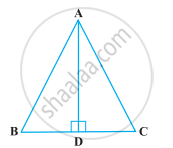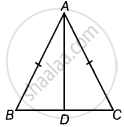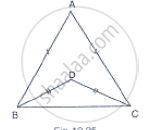Advertisements
Advertisements
प्रश्न
ABC is an isosceles triangle with AB = AC and D is a point on BC such that AD ⊥ BC (Figure). To prove that ∠BAD = ∠CAD, a student proceeded as follows:

In ∆ABD and ∆ACD,
AB = AC (Given)
∠B = ∠C (Because AB = AC)
and ∠ADB = ∠ADC
Therefore, ∆ABD ≅ ∆ACD (AAS)
So, ∠BAD = ∠CAD (CPCT)
What is the defect in the above arguments?
[Hint: Recall how ∠B = ∠C is proved when AB = AC].
उत्तर
In ∆ABC, AB = AC
⇒ ∠ACB = ∠ABC ...[Angles opposite to the equal sides are equal]
In ∆ABD and ∆ACD,
AB = AC ...[Given]
∠ABD = ∠ACD ...[Proved above]
∠ADB = ∠ADC ...[Each 90°]
∴ ∆ABD ≅ ∆ACD ...[By AAS]
So, ∠BAD = ∠CAD ...[By CPCT]
So, the defect in the given argument is that firstly prove ∠ABD = ∠ACD
Hence, ∠ABD = ∠ACD is defect.
APPEARS IN
संबंधित प्रश्न
Find the measure of each exterior angle of an equilateral triangle.
In figure, AB = AC and DB = DC, find the ratio ∠ABD : ∠ACD

Prove that each angle of an equilateral triangle is 60°.
ABC is a triangle in which BE and CF are, respectively, the perpendiculars to the sides AC and AB. If BE = CF, prove that ΔABC is isosceles
Which of the following statements are true (T) and which are false (F) :
If the altitude from one vertex of a triangle bisects the opposite side, then the triangle may be isosceles.
Which of the following statements are true (T) and which are false (F)?
Sum of any two sides of a triangle is greater than the third side.
In ∆ABC, AB = AC and ∠B = 50°. Then ∠C is equal to ______.
In triangles ABC and PQR, AB = AC, ∠C = ∠P and ∠B = ∠Q. The two triangles are ______.
M is a point on side BC of a triangle ABC such that AM is the bisector of ∠BAC. Is it true to say that perimeter of the triangle is greater than 2 AM? Give reason for your answer.
In a triangle ABC, D is the mid-point of side AC such that BD = `1/2` AC. Show that ∠ABC is a right angle.
